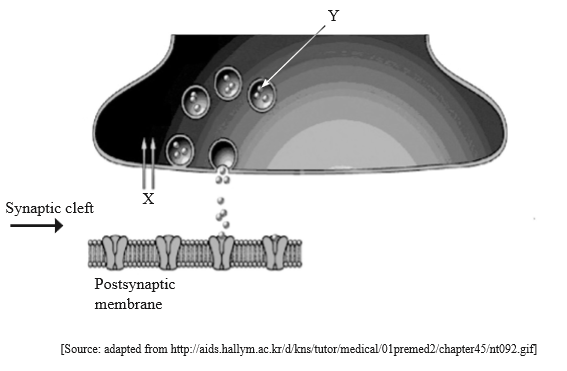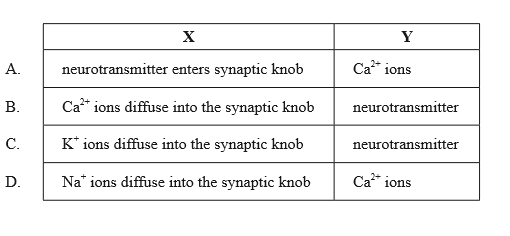IB Biology SL (Standard level)- 2024 – Practice Questions- All Topics
Topic 6.5 Neurons and synapses
Topic 6 Weightage : 23%
All Questions for Topic 6.5 – Neurons, Resting Potential, Action Potential, Nerve Impulses, Oscilloscope Traces, Myelination, Synaptic Transfer, Neurotransmitters, Graded Potentials, Nervous System, Stimulus-Response, Reflex Actions, Summation, Types of Neurotransmitters
Question
How do neonicotinoid pesticides cause paralysis and death in insects?
Acetylcholine receptors are blocked.
Cholinesterase fails to break down the pesticide.
The pesticides bind to presynaptic receptors.
I only
I and II only
I and III only
I, II and III
▶️Answer/Explanation
Ans: B
The correct answer is “I and II only”. Neonicotinoid pesticides bind to acetylcholine receptors in the nervous system of insects, which blocks the normal function of these receptors. This leads to paralysis and death in the insects. Additionally, neonicotinoids inhibit the activity of cholinesterase, which is an enzyme that breaks down acetylcholine in the nervous system. This causes an accumulation of acetylcholine, which can lead to overstimulation of the nervous system and further contribute to paralysis and death in the insects.
Which structure in the motor neuron is required for saltatory conduction?

[Source: https://commons.wikimedia.org/wiki/File:Anatomy_and_physiology_of_animals_Motor_neuron.jpg]
▶️Answer/Explanation
Markscheme
C
Myelin provides insulation for axons and is necessary for saltatory conduction. In given diagram myelin is represented with C. So the correct answer is C
If schizophrenia is caused by an overabundance of the neurotransmitters dopamine and serotonin in the synapses of some areas of the brain, which drug action could work in treating the symptoms?
A. Release of cholinesterase into the synaptic cleft
B. Increased re-uptake of dopamine and serotonin by presynaptic neurons
C. Increased permeability of the presynaptic neuron to sodium
D. Blockage of dopamine and serotonin receptors on presynaptic neurons
▶️Answer/Explanation
Markscheme
B
Schizophrenia is thought to be caused by an overabundance of dopamine and serotonin in certain areas of the brain. Antipsychotic drugs work by blocking the dopamine and serotonin receptors on presynaptic neurons, which reduces the amount of dopamine and serotonin released into the synapse. This helps to alleviate the symptoms of schizophrenia.
While it may seem counterintuitive that blocking dopamine and serotonin receptors could help reduce symptoms of schizophrenia caused by an overabundance of these neurotransmitters, the mechanism of action of antipsychotic drugs is actually quite complex. By blocking these receptors, the drugs reduce the activity of the dopamine and serotonin systems in the brain, which can help to correct the imbalance of neurotransmitters that is thought to underlie schizophrenia. Additionally, antipsychotic drugs may also affect other neurotransmitter systems in the brain, which can contribute to their therapeutic effects.
On the other hand, “increased re-uptake of dopamine and serotonin by presynaptic neurons” drug action would not be effective in treating schizophrenia because it would lead to a further reduction in the amount of dopamine and serotonin in the synapse, which could exacerbate the symptoms of the disorder.
So the correct answer will be D
Between which structures do sensory neurons carry nerve impulses?
A. From receptors to muscles
B. From effectors to the central nervous system (CNS)
C. From the central nervous system (CNS) to receptors
D. From receptors to the central nervous system (CNS)
▶️Answer/Explanation
Markscheme
D
The correct answer is “D. From receptors to the central nervous system (CNS)”. Sensory neurons carry nerve impulses from receptors, such as those in the skin, eyes, ears, and other sensory organs, to the central nervous system (CNS), which includes the brain and spinal cord. Once the sensory information reaches the CNS, it can be processed and integrated with other information to produce a response.
In the diagram of synaptic transmission below, what is indicated by the letters X and Y?


▶️Answer/Explanation
Markscheme
B
Calcium ions (Ca2+) diffuse into the synaptic terminal of a neuron through voltage-gated calcium channels in response to the arrival of an action potential. As the action potential travels down the axon of a neuron, it reaches the synaptic terminal and depolarizes the membrane. This depolarization opens the voltage-gated calcium channels, allowing calcium ions to enter the synaptic terminal. The influx of calcium ions triggers the release of neurotransmitter molecules from the synaptic vesicles, which then diffuse across the synaptic cleft and bind to receptors on the postsynaptic neuron. This process is crucial for the communication between neurons and the transmission of signals in the nervous system.
